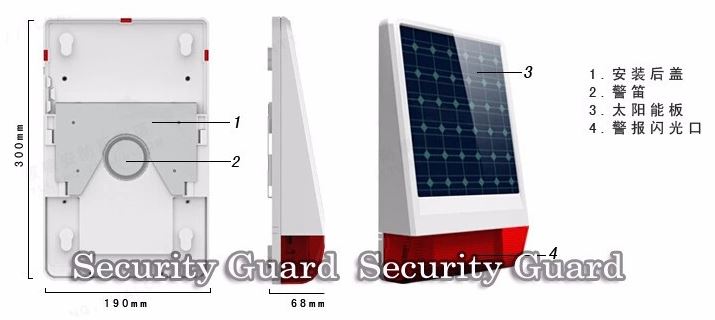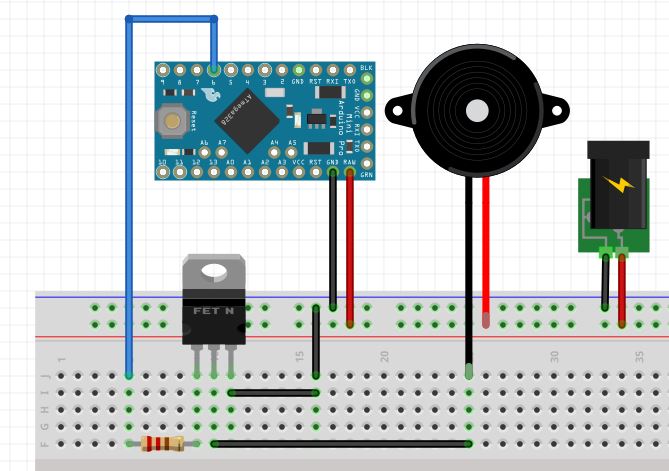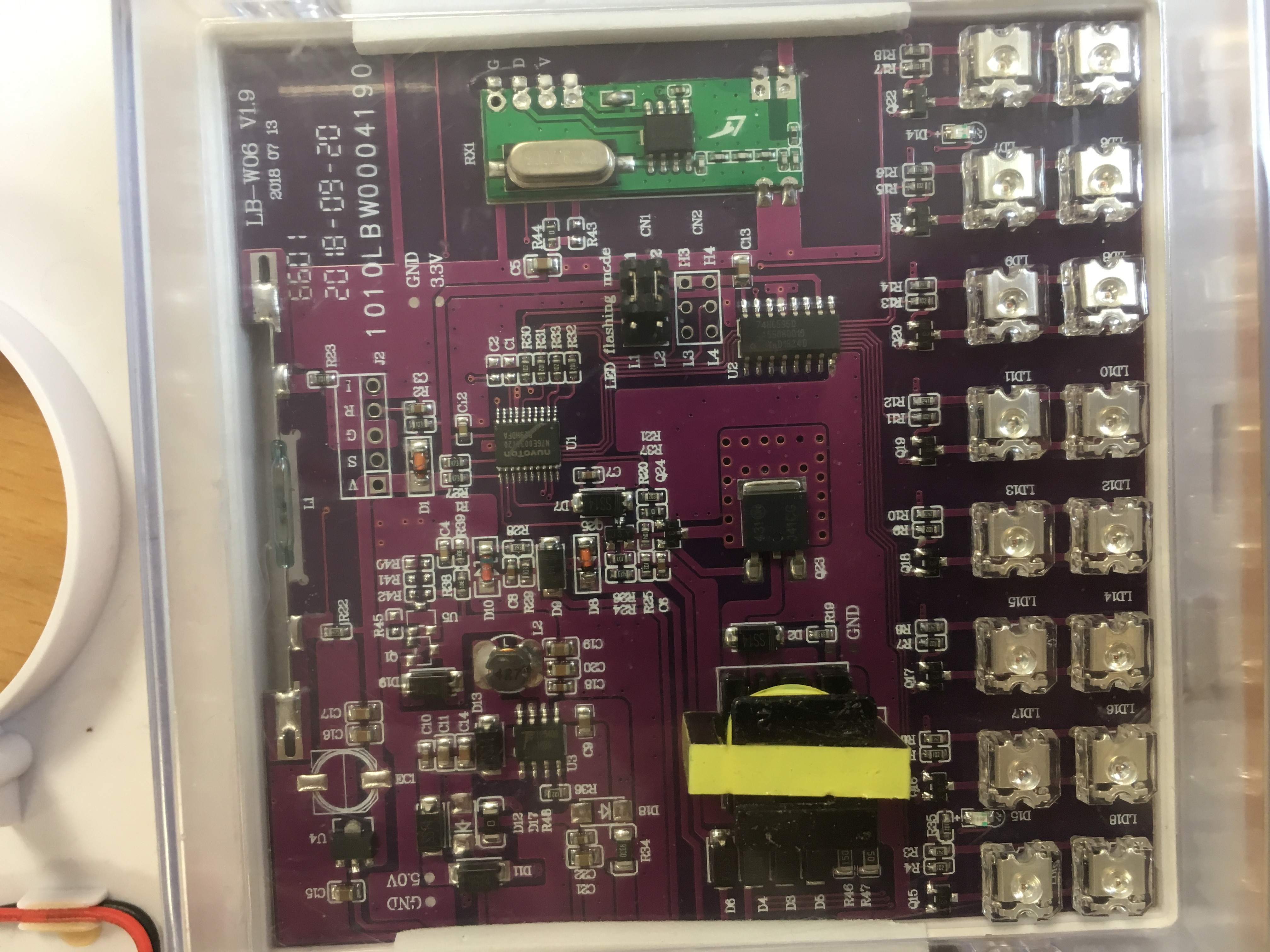Piezzo siren/alarm
-
Hi guys
I would be sooooo grateful if you could show me the path to get my piezzo buzzer up and running!
This is what i bought

My plan is to re-use the enclosure, solar panel (6V), siren, battery (3.7V 2200mAh) and possibly the LEDs.
But i'm already having some troubles with the piezzo siren module...
![0_1554800122288_IMG_0309[1].JPG](/assets/uploads/files/1554800141857-img_0309-1-resized.jpg)
Schematic
As it looks like a naked piezzo module (no oscillator inside, unknown voltage) I conected it to a PMW pin on Arduino with a Tone() sketch
There are some datasheets out there for similar buzzers, some are 5V others 12V... less than 200mA seems a good average. So i used a TIP120 (and even a BC238 but looked a bit undersized for 200mA)

What did I expect to happen?
A hell of a noise!!! (same as when i power the original unit)
What happened instead?
At best i get a cheap watch alarm noise when playing with different levels of Tone()
Applying different voltage doesn't change a thing: 1S, 2S and 3S generate the same amount of noise...The original board
From that picture can you tell if the voltage is boosted to a high voltage? Or any trickery that would explain my silent buzzer?
![0_1554824059739_IMG_0310[1].JPG](/assets/uploads/files/1554824082386-img_0310-1-resized.jpg)
Nasty part
I also tried to inject DC current to the poor piezzo unit :innocent: :smiling_imp:
Just made a "tic" sound when connected. And a "tic" every time a different voltage is applied. I went up to 12V (1S, 2S and 3S LiPo battery, from balancing plug)Any idea chaps? Thanks for your help.
-
Adafruit have this one, can you try to make your setup similar? Notice that you need to oscillate it at resonance frequency to provide loudest beep.
Piezo buzzers are used for making beeps, tones and alerts. This one is petite but loud! Drive it with 3-30V peak-to-peak square wave. To use, connect one pin to ground (either one) and the other pin to a square wave out from a timer or microcontroller. For the loudest tones, stay around 4 KHz, but works quite well from 2KHz to 10KHz. For extra loudness, you can connect both pins to a microcontroller and swap which pin is high or low ('differential drive') for double the volume.
https://www.adafruit.com/product/160
And maybe your piezo is just a quiet buzzer - try to scavenge a piezo from a smoke alarm, that will give you around 105dB, and notice they have 3 pins and not only 2 pins
https://electronics.stackexchange.com/questions/18212/whats-the-third-wire-on-a-piezo-buzzer -
Hi guys
I would be sooooo grateful if you could show me the path to get my piezzo buzzer up and running!
This is what i bought

My plan is to re-use the enclosure, solar panel (6V), siren, battery (3.7V 2200mAh) and possibly the LEDs.
But i'm already having some troubles with the piezzo siren module...
![0_1554800122288_IMG_0309[1].JPG](/assets/uploads/files/1554800141857-img_0309-1-resized.jpg)
Schematic
As it looks like a naked piezzo module (no oscillator inside, unknown voltage) I conected it to a PMW pin on Arduino with a Tone() sketch
There are some datasheets out there for similar buzzers, some are 5V others 12V... less than 200mA seems a good average. So i used a TIP120 (and even a BC238 but looked a bit undersized for 200mA)

What did I expect to happen?
A hell of a noise!!! (same as when i power the original unit)
What happened instead?
At best i get a cheap watch alarm noise when playing with different levels of Tone()
Applying different voltage doesn't change a thing: 1S, 2S and 3S generate the same amount of noise...The original board
From that picture can you tell if the voltage is boosted to a high voltage? Or any trickery that would explain my silent buzzer?
![0_1554824059739_IMG_0310[1].JPG](/assets/uploads/files/1554824082386-img_0310-1-resized.jpg)
Nasty part
I also tried to inject DC current to the poor piezzo unit :innocent: :smiling_imp:
Just made a "tic" sound when connected. And a "tic" every time a different voltage is applied. I went up to 12V (1S, 2S and 3S LiPo battery, from balancing plug)Any idea chaps? Thanks for your help.
-
@mfalkvidd hi thank you for your answer.
I did try to take measurment with my voltmeter but it is kinda slow to react.
The 'welcome' tone when powering the board lasts about half a second... so no luck there.Might be time to buy one of those very affordable oscilloscope from eBay or aliExpress... do you own one?
-
Adafruit have this one, can you try to make your setup similar? Notice that you need to oscillate it at resonance frequency to provide loudest beep.
Piezo buzzers are used for making beeps, tones and alerts. This one is petite but loud! Drive it with 3-30V peak-to-peak square wave. To use, connect one pin to ground (either one) and the other pin to a square wave out from a timer or microcontroller. For the loudest tones, stay around 4 KHz, but works quite well from 2KHz to 10KHz. For extra loudness, you can connect both pins to a microcontroller and swap which pin is high or low ('differential drive') for double the volume.
https://www.adafruit.com/product/160
And maybe your piezo is just a quiet buzzer - try to scavenge a piezo from a smoke alarm, that will give you around 105dB, and notice they have 3 pins and not only 2 pins
https://electronics.stackexchange.com/questions/18212/whats-the-third-wire-on-a-piezo-buzzer -
@mfalkvidd hi thank you for your answer.
I did try to take measurment with my voltmeter but it is kinda slow to react.
The 'welcome' tone when powering the board lasts about half a second... so no luck there.Might be time to buy one of those very affordable oscilloscope from eBay or aliExpress... do you own one?
@ben999 I bought a cheap oscilloscope kit a while ago. Photos: https://forum.mysensors.org/topic/7836/what-did-you-build-today-pictures/603
Graphs: https://forum.mysensors.org/topic/7836/what-did-you-build-today-pictures/614This kit is very basic, but works for most of my needs.
-
@ben999 I bought a cheap oscilloscope kit a while ago. Photos: https://forum.mysensors.org/topic/7836/what-did-you-build-today-pictures/603
Graphs: https://forum.mysensors.org/topic/7836/what-did-you-build-today-pictures/614This kit is very basic, but works for most of my needs.
@mfalkvidd oh thanks for quick reply and links.
A bit off-topic here: would you rather go for a computer version or a portable one ?
-
@mfalkvidd oh thanks for quick reply and links.
A bit off-topic here: would you rather go for a computer version or a portable one ?
@ben999 I am not sure I know the difference between portable and computer version, but I'll try to answer anyway. As with most things, it depends on the use case.
Last weekend I went to a hackathon. I brought my oscilloscope since it doesn't weigh much and doesn't take up much space. Most "real" oscilloscopes would have been too large and heavy to bring, especially since I don't travel by car.
I usually have a computer when messing with electronics, so I don't mind using the computer's screen instead of a built-in screen. Having the user interface on my computer makes it easy to take screen shots.
-
For portable usage I have a https://pokitmeter.com/ which is really small and lightweight.
-
For portable usage I have a https://pokitmeter.com/ which is really small and lightweight.
@fotofieber woooooooooooooooow :heart_eyes_cat: :heart_eyes_cat: :heart_eyes_cat:
I searched last night for something similar (iOS and BT) but couldn't find one
So i bought a cheap portable one on aliExpress
We're not talking about the same amount of money there...
But i'm now deeeeeeeeeply in love and will consider PokitMeter for my next workshop toy :heart_eyes:
Thank you for the link :facepunch: :+1:
-
@mfalkvidd Something puzzling me here, can i please borrow your brain for a sec ?
@bjacobse mentionned that his small piezzo buzzer could take up to 30V...
So i had a go with my own buzzer and the previous schematic with 1S LiPo up to 6S LiPo (close to 25V) and 440Hz up to 32kHz (max Tone() )
No change there. Still the same noise i got with a smaller transistor and a 5V power supply.
Tone() changes the width of the modulation (X scale), so i get different tones.
Voltage of the power suppy changes the power going through the piezzo disc... but it doesn't get any louder.So what is the magic to get a loud buzzer? I shall get my oscilloscope within a month, so until then i keep scratching my head !!
-
@mfalkvidd Something puzzling me here, can i please borrow your brain for a sec ?
@bjacobse mentionned that his small piezzo buzzer could take up to 30V...
So i had a go with my own buzzer and the previous schematic with 1S LiPo up to 6S LiPo (close to 25V) and 440Hz up to 32kHz (max Tone() )
No change there. Still the same noise i got with a smaller transistor and a 5V power supply.
Tone() changes the width of the modulation (X scale), so i get different tones.
Voltage of the power suppy changes the power going through the piezzo disc... but it doesn't get any louder.So what is the magic to get a loud buzzer? I shall get my oscilloscope within a month, so until then i keep scratching my head !!
@ben999
I guess you don't hit resonance frequency.
Why not scavenge a piezo from a smokealarm, then you you know that the circuit is made for resonance frequency.
BTW I did not write MY piezo is working at 30V, I directed to a piezo that Adafruit is using, and that uses up to 30V - just to correct that I hvae not used the pieo myself -
@ben999
I guess you don't hit resonance frequency.
Why not scavenge a piezo from a smokealarm, then you you know that the circuit is made for resonance frequency.
BTW I did not write MY piezo is working at 30V, I directed to a piezo that Adafruit is using, and that uses up to 30V - just to correct that I hvae not used the pieo myself -
@bjacobse thanks for clarification :smile:
No smoke came out of mine under 25V DC so i guess it's ok
And yes, i shall cut open an old smoke alarm, you're right.
Thanks a lot
-
AFAIK the piezo acts like a capacitor. If you don't use AC, you may have to discharge it with a parallel resistor or discharge it with a transistor.
You could find some useful information on eevblog, e.g. http://www.eevblog.com/forum/projects/how-to-connect-a-piezo-speaker-to-a-microcontroller/
toneAC:
https://bitbucket.org/teckel12/arduino-toneac/wiki/Home -
AFAIK the piezo acts like a capacitor. If you don't use AC, you may have to discharge it with a parallel resistor or discharge it with a transistor.
You could find some useful information on eevblog, e.g. http://www.eevblog.com/forum/projects/how-to-connect-a-piezo-speaker-to-a-microcontroller/
toneAC:
https://bitbucket.org/teckel12/arduino-toneac/wiki/Home@fotofieber hi thank you for your message
I was coming back here to share my findings.... been playing with... ToneAC :joy:
Yes you're right, differential drive makes a hell of a difference! each pin of the piezo speaker are connected to its own arduino output (serial resistor on one pin though) that send the same signal in opposition as to get a differential movment.
But i don't quite get it :
- driving the piezo speaker with up to 25V doesn't improve noise level at all
- switching to differential drive @5V (so it's a 10V potential peak-to-peak) opens hell's doors wide open
That's the part i dont understand. I'll carry on investigating.
Still: noise level is a bit below as compared to same pizeo speaker connected to original alarm enclosure...
I might have a go with transistors and try a differential of 2S or 3S LiPo.
Also waiting for my oscilloscope to find out!And lastly: ToneAC uses pins 9 and 10... so it's a NO-NO with nRF24 :cry:
Enters... ToneAC2. It's inferior (CPU cycle, accuracy, lower freq) in many points except that pins are configurable.More soon... :nerd_face:
-
@fotofieber hi thank you for your message
I was coming back here to share my findings.... been playing with... ToneAC :joy:
Yes you're right, differential drive makes a hell of a difference! each pin of the piezo speaker are connected to its own arduino output (serial resistor on one pin though) that send the same signal in opposition as to get a differential movment.
But i don't quite get it :
- driving the piezo speaker with up to 25V doesn't improve noise level at all
- switching to differential drive @5V (so it's a 10V potential peak-to-peak) opens hell's doors wide open
That's the part i dont understand. I'll carry on investigating.
Still: noise level is a bit below as compared to same pizeo speaker connected to original alarm enclosure...
I might have a go with transistors and try a differential of 2S or 3S LiPo.
Also waiting for my oscilloscope to find out!And lastly: ToneAC uses pins 9 and 10... so it's a NO-NO with nRF24 :cry:
Enters... ToneAC2. It's inferior (CPU cycle, accuracy, lower freq) in many points except that pins are configurable.More soon... :nerd_face:
-
@fotofieber hi thank you for your message
I was coming back here to share my findings.... been playing with... ToneAC :joy:
Yes you're right, differential drive makes a hell of a difference! each pin of the piezo speaker are connected to its own arduino output (serial resistor on one pin though) that send the same signal in opposition as to get a differential movment.
But i don't quite get it :
- driving the piezo speaker with up to 25V doesn't improve noise level at all
- switching to differential drive @5V (so it's a 10V potential peak-to-peak) opens hell's doors wide open
That's the part i dont understand. I'll carry on investigating.
Still: noise level is a bit below as compared to same pizeo speaker connected to original alarm enclosure...
I might have a go with transistors and try a differential of 2S or 3S LiPo.
Also waiting for my oscilloscope to find out!And lastly: ToneAC uses pins 9 and 10... so it's a NO-NO with nRF24 :cry:
Enters... ToneAC2. It's inferior (CPU cycle, accuracy, lower freq) in many points except that pins are configurable.More soon... :nerd_face:
@ben999 said in Piezzo siren/alarm:
But i don't quite get it :
driving the piezo speaker with up to 25V doesn't improve noise level at all
switching to differential drive @5V (so it's a 10V potential peak-to-peak) opens hell's doors wide openYou may try to use a 1kOhm resistor parallel to the piezo (as suggested on eevblog).
-
@ben999 nice work, thanks for sharing.
To change pins for the nrf24, use the following in your sketch
#define MY_RF24_CE_PIN 7 #define MY_RF24_CS_PIN 8@mfalkvidd oh yeah I forgot about that one!!! Thanks a lot! I have used this with a Mega for who-knows-what-reason in the past but completely forgot about it! ToneAC still in the race then, thanks again
@fotofieber thanks a lot, but that thread is for high-level hobbyists!!! :scream: Schematics, yummy!!!
"replace the resistor with an inductor then you double the swing" but no figures... i'll google that and see where it gets me...
I dont even know the specs of my piezo :zipper_mouth_face: -
@mfalkvidd oh yeah I forgot about that one!!! Thanks a lot! I have used this with a Mega for who-knows-what-reason in the past but completely forgot about it! ToneAC still in the race then, thanks again
@fotofieber thanks a lot, but that thread is for high-level hobbyists!!! :scream: Schematics, yummy!!!
"replace the resistor with an inductor then you double the swing" but no figures... i'll google that and see where it gets me...
I dont even know the specs of my piezo :zipper_mouth_face:@ben999 said in Piezzo siren/alarm:
@fotofieber thanks a lot, but that thread is for high-level hobbyists!!! Schematics, yummy!!!
"replace the resistor with an inductor then you double the swing" but no figures... i'll google that and see where it gets me...
I dont even know the specs of my piezoI try to simplify: Take a 1 kOhm resistor and attach each side of it to another pin of the piezo. Don't change anything else.


